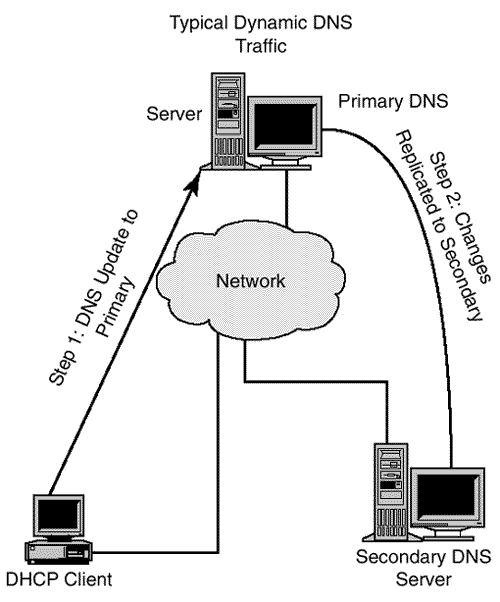Dynamic Host Configuration Protocol (DHCP) and DNS
DHCP works closely with DNS in Microsoft's Windows 2000 and Active Directory. DHCP assigns addresses dynamically to any DHCP client, including Microsoft Windows 2000 clients. After the address is assigned, the DHCP client and/or the DHCP server can update DNS resource record and the PTR resource record in your DNS zone with an Alias (A). This is supported through the dynamic update as defined in RFC2136.
This provides for an accurate DDNS environment without human intervention. When a client computer starts, it requests an IP address and corresponding TCP/IP configuration parameters from the local DHCP server. You can configure the server and clients so that one of three scenarios takes place. The three scenarios are
The client updates both the A and PTR records.
The DHCP server updates both the A and PTR records.
The DHCP server updates the A record and the client updates the PTR record.
By default, the client (host) updates the A record and the DHCP server updates the PTR record.
The capability to configure whether the server or the client updates DNS is important for coexistence phases. If you are supporting down-level clients, such as Windows 95, you need to have the DHCP server update the records because the client does not support this. If you are running with Windows NT 4.0 as your DHCP server and you have migrated the clients to Windows 2000, your DHCP client needs to make both updates to DNS because Windows NT 4.0 DHCP does not support updating DNS.
Microsoft's DNS implementation also has a unique feature that is available if DNS uses Active Directory as the replication agent. In this scenario, each instance of the DNS database on a Windows 2000 server is a primary master that can be updated. Changes to DNS are then replicated using Active Directory. Figure 8.1 depicts the typical scenario in which the primary master DNS server must be updated directly. This can create a bottleneck if many systems are coming online at the same time. With the Microsoft DNS sequence that is depicted in Figure 8.2, the changes are made to a local DNS and those changes are replicated using Active Directory.
Figure 8.1. Typical DNS traffic patterns.


